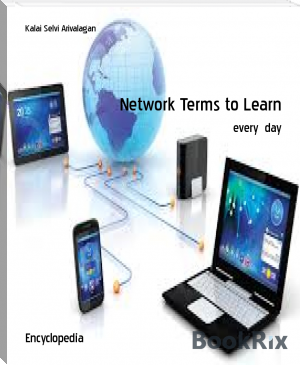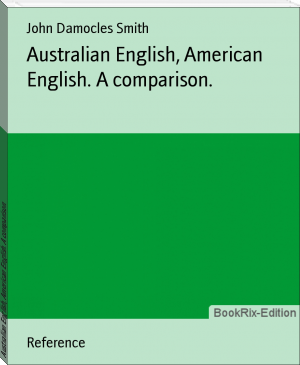Network Terms to Learn - Kalai Selvi Arivalagan (best love novels of all time .TXT) 📗

- Author: Kalai Selvi Arivalagan
Book online «Network Terms to Learn - Kalai Selvi Arivalagan (best love novels of all time .TXT) 📗». Author Kalai Selvi Arivalagan
Business Continuity Plan
A business continuity plan (BCP) is a plan to help ensure that business processes can continue during a time of emergency or disaster. Such emergencies or disasters might include a fire or any other case where business is not able to occur under normal conditions. Businesses need to look at all such potential threats and devise BCPs to ensure continued operations should the threat become a reality.
A business continuity plan involves the following:
Analysis of organizational threats
A list of the primary tasks required to keep the organization operations flowing
Easily located management contact information
Explanation of where personnel should go if there is a disastrous event
Information on data backups and organization site backup
Collaboration among all facets of the organization
Buy-in from everyone in the organization
Access Modifiers
Access modifiers are keywords used to specify the accessibility of a class (or type) and its members. These modifiers can be used from code inside or outside the current application. Access modifiers in .NET are used to control the accessibility of each of the members of a type from different possible areas of code. This can be handled from within the current assembly or outside it. An assembly represents a logical unit of functionality and consists of types and resources located in one or more files.
The purpose of using access modifiers is to implement encapsulation, which separates the interface of a type from its implementation. With this, the following benefits can be derived:
Non-Deterministic Turing Machine
A non-deterministic Turing machine is a theoretical type of computer in which specific commands may allow for a range of actions, rather than a specific command leading to only one allowable action in the deterministic model of computing. Where deterministic programming is a simple condition of "input X leads to action Y", a non-deterministic Turing machine setup would theoretically allow for input X to lead to a variety of actions Y(array).
Real-Time Strategy
Real-time strategy (RTS) refers to a time-based video game that centers around using resources to build units and defeat an opponent. Real-time strategy games are often compared to turn-based strategy games, where each player has time to carefully consider the next move without having to worry about the actions of his opponent. In real-time strategy games, players must attempt to build their resources, defend their bases and launch attacks while knowing that the opponent is scrambling to do the same things. A real-time strategy game may also be referred to as a real-time simulation or a real-time war game.
Cloud Services
Cloud services refer to any IT services that are provisioned and accessed from a cloud computing provider. This is a broad term that incorporates all delivery and service models of cloud computing and related solutions. Cloud services are delivered over the internet and accessible globally from the internet.
Business Intelligence Architect
A business intelligence architect (BI architect) is a top-level sort of business intelligence analyst who deals with specific aspects of business intelligence, a discipline that uses data in certain ways and builds specific architectures to benefit a business or organization. The business intelligence architect will generally be responsible for creating or working with these architectures, which serve the specific purpose of maximizing the potential of data assets.
Narrow Artificial Intelligence (Narrow AI)
Narrow artificial intelligence (narrow AI) is a specific type of artificial intelligence in which a learning algorithm is designed to perform a single task, and any knowledge gained from performing that task will not automatically be applied to other tasks.
Unlike general artificial intelligence, which seeks to mimic complex thought processes, narrow AI is designed to successfully complete a single task without human assistance. Popular applications for narrow AI include language translation and image recognition.
Most AI applications in use today can be categorized as being narrow AI. Narrow AI may also be referred to as weak AI.
Narrow Continuous Integration Learning
In software development, continuous integration (CI) is the practice of regularly committing code changes to a version control system that can test and deploy code automatically. The term is often mentioned in tandem with continuous delivery, an approach in which code is tested automatically, but is released into production manually. CI/CD uses an iterative approach to releasing code and can be contrasted with the traditional waterfall method of software development.
Integration Platform as a Service (iPaaS)
Integration platform as a service (iPaaS) is a cloud service that allows software developers to automate how on-premises and cloud-based applications securely share data. An important goal of iPaaS is to simplify management of complex hybrid cloud and multi-cloud architectures. The challenge is that even when simplified, real-time data flows in hybrid and multi-cloud environments can still be very complex.
iPaaS cloud services provide customers with access to an executive dashboard that can easily be customized with pre-built connectors and business rules. The service provider is responsible for handling the back-end services that support hardware management and data governance, including encryption. To accommodate small and mid-size businesses, an increasing number of iPaaS vendors are offering low-code/no-code (LCNC) versions of their iPaaS services. LCNC dashboards allow non-technical line of business (LOB) employees to connect on-premises and cloud applications and synchronize data flows without help from their IT department.
Term of the day - 20 Appending Virus
An appending virus is a type of virus that adds its code to the end of the file of a host program. Its goal is not to destroy the host program, but to slightly modify it so that it will hold the virus code while continuing to operate.
The appending virus copies the first bytes of its code to a safe location and then adds a jump to its code at the beginning of the program that is to run just before the host takes control. Contrary to an overwriting virus, this virus does not permanently destroy any part of the host program, which makes it more difficult to detect the infection.
ACCDB File Format
The .accdb file format is the default file-saving format for the Microsoft Access 2007 and 2010 database applications. Previous versions of Microsoft Access, like 2000 and 2003, use the .mdb file format by default.
Candidate Key
A candidate key is a column, or set of columns, in a table that can uniquely identify any database record without referring to any other data. Each table may have one or more candidate keys, but one candidate key is unique, and it is called the primary key. This is usually the best among the candidate keys to use for identification. When a key is composed of more than one column, it is known as a composite key.
Banker Trojan
A banker Trojan is a piece of malware intended to get financial information or hack users through a banking or financial system, commonly through an online banking or brokerage interface.
Run of Channel
In the marketing world, “run of channel” (ROC) refers to an ad component that gets displayed on multiple digital channels. Some of the most prominent definitions of run of channel talk about various channels of a company's website – and others talk about external channels, including social media and others. Run of channel simply means that there is a strategic effort to display the same ad component in multiple places.
Long Short-Term Memory
Long short-term memory (LSTM) units or blocks are part of a recurrent neural network structure. Recurrent neural networks are made to utilize certain types of artificial memory processes that can help these artificial intelligence programs to more effectively imitate human thought.
Rotoscoping
Rotoscoping is a technique used in physical animation. This technique allows human users to trace drawings frame by frame. It can also bring a sense of realism to projects and was heavily used in developing the kinds of modern physical animation used today.
Operating System Virtualization
Operating system virtualization (OS virtualization) is a server virtualization technology that involves tailoring a standard operating system so that it can run different applications handled by multiple users on a single computer at a time. The operating systems do not interfere with each other even though they are on the same computer. In OS virtualization, the operating system is altered so that it operates like several different, individual systems. The virtualized environment accepts commands from different users running different applications on the same machine. The users and their requests are handled separately by the virtualized operating system. Also known as operating system-level virtualization.
Self-Replicating Machine
Self-replicating machines are a category of autonomous robot that can make copies or reproduce themselves autonomously with help of raw materials from the existing environment. The self-replicating machine is based on the concept of self-replication as found in the nature. Further development of the self-replicating machine concept is considered a critical part of many future plans, like the mining of asteroid belts and moons for minerals and ores.
Workspace as a Service (WaaS)
The term "workspace as a service" (WaaS) in IT refers to services that provide end users with a virtual workspace, which is a model of the kinds of resources end users would have at their desk within a physical office environment.
Non-Deterministic Polynomial Time
Non-deterministic polynomial time (NP) is actually a marker used to point to a set of problems and bounds of the capability of certain types of computing. NP refers to the set of problems that can be solved in polynomial time by a non-deterministic Turing machine.
Erlang Programming Language
The Erlang programming language is a general-purpose, simultaneous and garbage-collected programming language, which also serves as a runtime system. The sequential derivative of Erlang is a functional language with firm calculation, single assignment and dynamic data entry, which concurrently follows the Actor model. Developed by Joe Armstrong in 1986, Erlang was first released by Ericsson as a proprietary language, then released in 1998 as an open source language. Ericsson engineered Erlang to support distributed, fault-tolerant, soft-real-time and non-stop applications. Erlang supports hot swapping; thus code can be replaced without restarting the system.
Capsule Network
A capsule network is a kind of shorthand term for a specific kind of neural network pioneered by Stanford scientist Geoffrey Hinton. In the capsule network, specific methodology is applied to image processing to try to affect an understanding of objects from a three-dimensional spectrum.
Mobile Augmented Reality Application (MARA)
A mobile augmented reality application (MARA) is a type of mobile application that incorporates and complements built-in components in a mobile phone and provides a specialized application to deliver reality-based services and functions. A MARA uses the architectural composition of a mobile phone to deliver applications that add value to the physical world through virtual data and services.
Internet of Overwhelming Things (IoOT)
The Internet of Overwhelming Things (IoOT) refers to the effects of the Internet of Things (IoT) on the IT world. The Internet of Things refers to the concept of a network of physical objects, including traditional home appliances or everyday gadgets/devices, that can connect to the global Internet.
Web Mining
Web mining is the process of using data mining techniques and algorithms to extract information directly from





Comments (0)